It was the last Saturday of May and it was already time to go. After spending more than a week in the Fiordland National Park, walking around this New Zealand’s jewel, and a few days in Invercargill waiting for the weather forecast to get better, it was now or never. The forecast predicted a splendid weather until the following Monday, perfect to finish the 3 days of trekking on the Rakiura Track, one of the 9 Great Walks of New Zealand.
The ferry was scheduled to leave the Bluff harbor at 9:30 PM in the direction of Oban. This city is the only one on Stewart Island, with 381 inhabitants, which is almost all of the population of the island. It’s also named Rakiura, a Maori name with several meanings, but we will go by the Glowing Skies translation, a reference to the sunsets or to the Aurora Australis. The Southern light, which I dreamt about seeing there, is probably one of the best places easily reachable on this side of the globe.
Once arrived in Oban, I booked the huts in the DOC (Department of Conservation) office, Port William for the first night and North Arm for the second night. The track doesn’t really start from Oban but 5km further. While a shuttle could have gotten me there, I decided to walk. Instead of staying on the asphalt road, I choose to walk along the Horseshoe Bay, a magnificent beach introducing me to the beauty of the island. A few minutes later, I left the last houses behind me to enter the Rakiura National Park.
The track, which is well maintained by the DOC, goes along the coast, sometimes sinking into the forest. It offers a unique sight and reveals one of the treasures of Rakiura: spectacular beaches where the vegetation overflows from all sides as if it was trying to push back the sea. Yet, even if it is a calm day, it is this same vast expanse which draws the outlines of the island, cuts off the cliffs and refines the curves of the sand stretches. Although the coast is mainly composed of rocks, the low tide sometimes brings out these pristine beaches, the opportunity to avoid a section of the track in the forest. The vegetation isn’t so different from the South Island but its inhabitants are, especially the birds. Several species are only present on a few New Zealand islands including the Stewart Island. The best known and the most sought-after bird by visitors is the Stewart Island brown kiwi, a subspecies of the Southern brown kiwi (Apteryx Australis). The kakapo (Strigops habroptilus), a large nocturnal and herbivorous parrot, is also unique in its kind. Besides living at night, it shares another common trait with the kiwi: it doesn’t fly. It is easy to understand why these birds almost disappeared with the arrival of humans and the predators they brought with them. On the island, predators are much rarer.
After two hours of walking, I reached Māori Beach and decided to take a break, alone in the middle of nowhere. Well, almost alone. The sandflies (these lovely flies sucking your blood) gave me a warm welcome, especially when I decided to remove my shoes to feel the sand between my toes:

I only had 4 km of walking to do before arriving at Port William, the last stop of the day. A suspension bridge made me plunge back into the already dark forest while it was only 3 PM. The days are short on the island at this time of year.
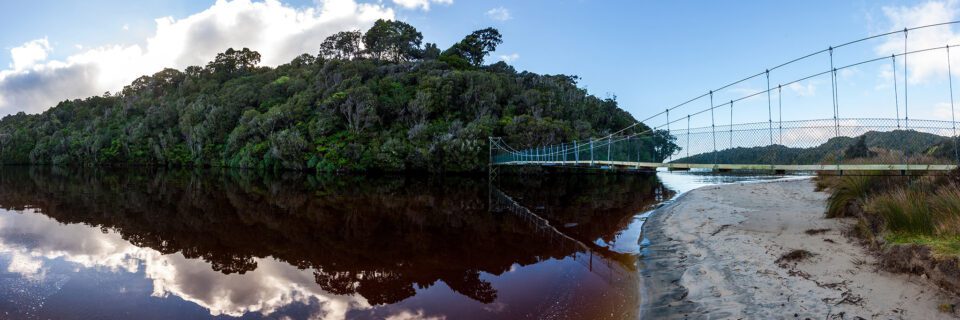
The sun, however, occasionally pierces the dense cover formed by one of the southernmost Podocarpaceae (a family of conifers) forest in the world, or the widespread rata and kamahi.
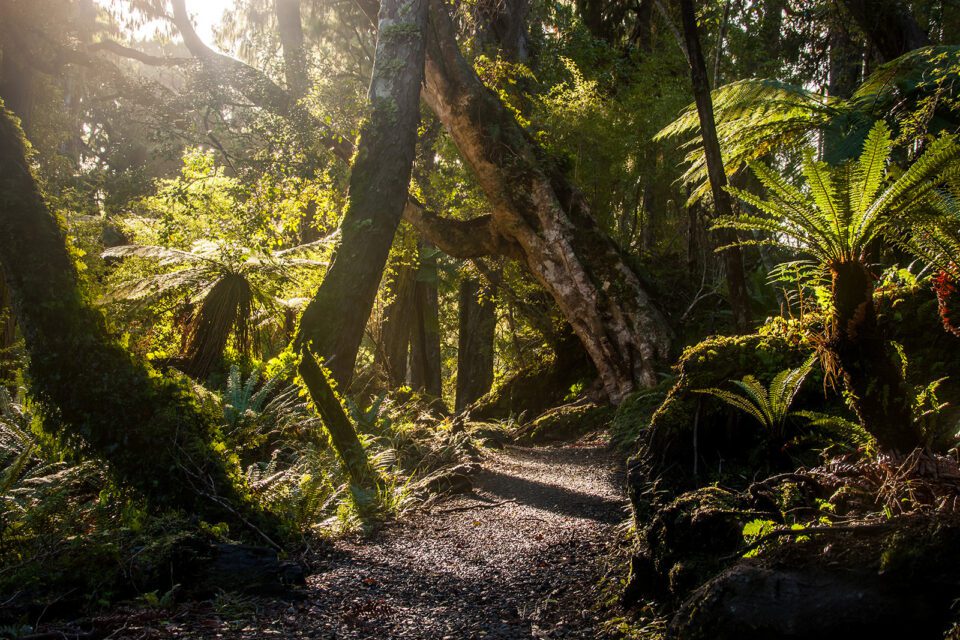
I arrived at the hut before sunset and sat down next to the wood-burner already lit by two other hikers. The night fell and there were no solar lights or candles to light up the room: it was time to eat before going on a kiwi “hunt”! While waiting for the others to get ready, I decided to go outside for a quick look at the sky, hoping to see light coming from the south. Nada.
Before coming on the island, I followed the forecasts for Aurora Australis. A solar flare happened earlier that week, announcing Southern light likely to be seen during the weekend, depending on the speed of the solar wind. The Southern light takes place when electrons and positive ions eject from the upper atmosphere of the Sun and penetrate into the Earth’s atmosphere near the Southern pole. These particles, once in contact with the atoms of our upper atmosphere, lead to a reaction that produces light, the color of which depends on the nature of the ions and therefore on the altitude at which the reaction is caused. The intensity of the Aurora is related to several parameters: the speed of the solar wind, its density and the direction of the magnetic field, also called Bz. The Bz is probably the #1 influencing factor in whether or not an Aurora will be visible within the next hour. In the southern hemisphere, the larger the negative number, generally the brighter the aurora. For example, a Bz of -20nT will produce a brighter aurora than a Bz of -5nT. A planetary index, the kP, is generally used to indicate and predict the strength of the geomagnetic storm, from 0 to 9. Above 4, the Aurora is usually visible in southern New Zealand. There is, however, a problem with this index: the kP is an average of k-indices from around the world. This data comes from 8 sensors and only 1 of them is located in the southern hemisphere. This makes the kP index biased to the northern hemisphere. Well, I didn’t have any phone reception there anyway, so I did not really care about this issue.
Although the Aurora didn’t show up, the Milky Way started to emerge. I seized the moment and positioned myself at the end of the wharf of Port William giving an incredible panoramic view on the bay. While there is no light pollution in the vicinity, the sky reveals orange glows on the horizon. A shooting star gratifies me of its passage next to the Milky Way in one of the seven pictures of this panorama:

After staying a few more minutes to admire one of the darkest skies I have ever seen, I decided to move and look for the discreet kiwi. Discreet? Not all that much actually. It is not difficult to hear it, but to see it is a whole different level in comparison. This nocturnal bird likes forest edges, sometimes venturing to an open environment where it’s certainly easier for it to move. I decided to wait for it in the Port William campsite. I could hear it scream and walk in the forest, its steps being as loud as a human who would seek his way through the bush. But I could see nothing. I moved to another location in the hopes of seeing it, but still got nothing. I then came back to the campsite and…waited, arming myself with patience and silence.
The kiwi was getting closer, its steps were louder and louder and then…there it was! A first kiwi came out from the forest and walked towards me, obviously too busy to worry about my presence. It completely ignored me. A second one appeared later, but it was the first, the much bigger than its neighbor, which attracted my attention. This animal is incredibly strange, funny and truly captivating. I was amazed by its quick movements to look into the grass, using its long curved beak. The kiwi was only a few meters away from me and I really thought about taking a picture, but I decided to instead enjoy the moment with my own eyes, since the photo would not have been able to capture the fast and the erratic-moving bird anyway. A few minutes later, it disappeared as it appeared – not without discretion. That night will remain in my memory for a long, long time…
The alarm went off at 7 AM the following day. At that moment, I could hardly imagine what Rakiura was going to offer. I covered myself up, took my tripod, my camera, my two lenses and I was on my way to enjoy my first sunrise on the island of the glowing sky. A slight mist rose from the calm waters of the bay. The sun shone through the bay and ignited it for a few moments.
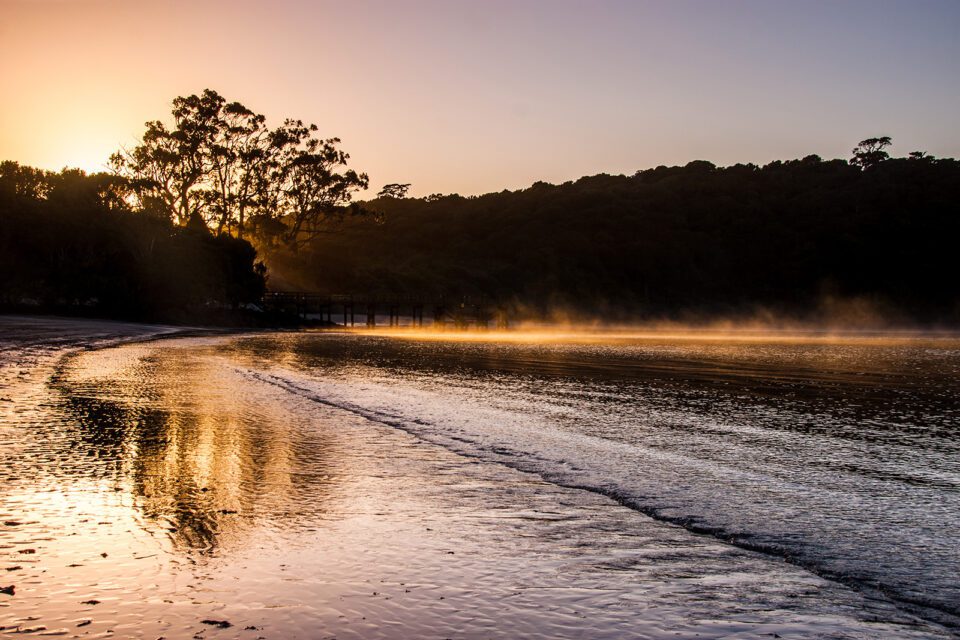
I then lost myself admiring the patterns on the beach, multiple veins drawn by the water flow on the sand:
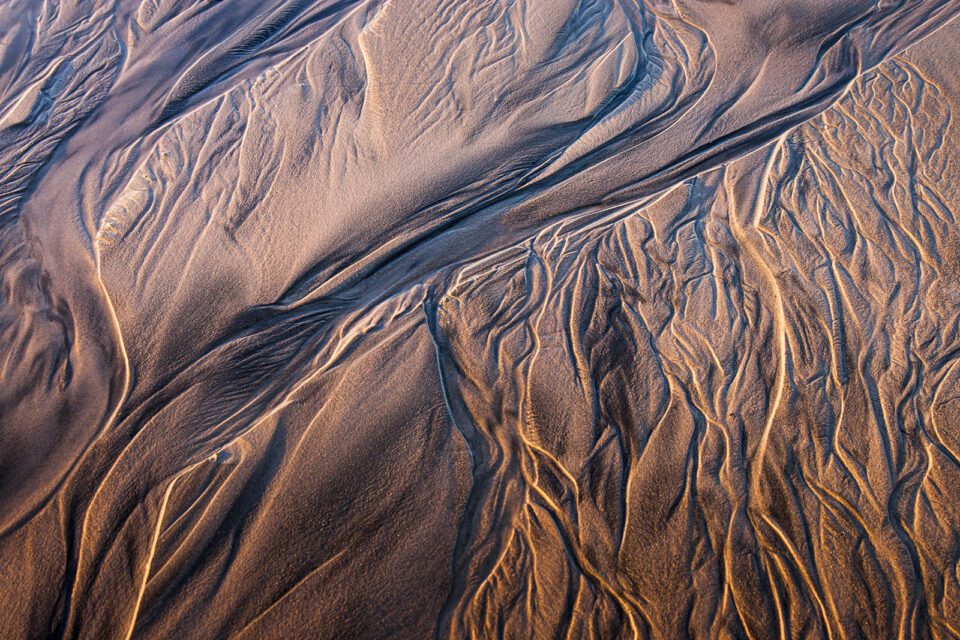
I went back to the hut to have a quick breakfast before launching myself into the track. The others were already all gone – I didn’t even realize that I spent nearly three hours to contemplate and photograph the awakening of the island. I decided to walk this section of the track, entirely forest, in one go. Less than four hours later, I was in the North Arm Hut after 12 km of walking. But I actually took a break on the way. Lost in my thoughts, I paid little attention to what was going on around me until the flapping of rather noisy wings made me raise my head. A parrot! Well, obviously it was not the kakapo, unless it learned to fly somehow. It was the New Zealand kaka (Nestor meridionalis). Nestor didn’t seem to be disturbed by my presence, sometimes approaching me as close as a few meters, as it frantically removed the bark of the trees:

It was 4 PM and the sun was already close to the horizon. I dropped my backpack off at the North Arm hut and headed for the bay. The track to get there, of no more than a hundred meters, leads to emerged rocks oriented towards the west, the beach still being under the water. Perfect for the sunset!
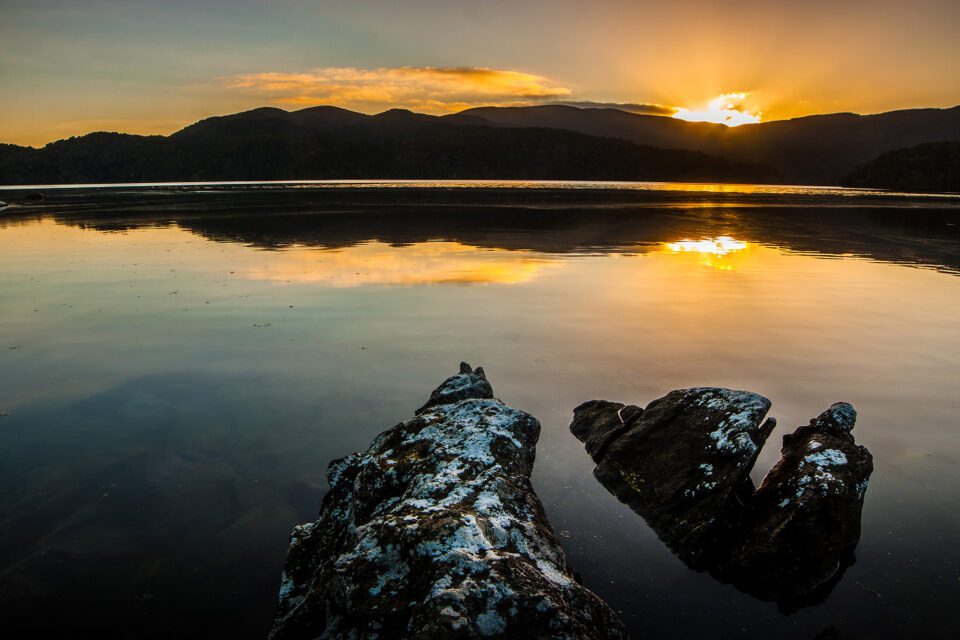
Once the sun was hidden by the hills, the cold began to invade the bay. It was time to get warm and eat some noodles. This time, a few candles allowed us to keep the room lit up and play cards. Like the previous night, I left the hut at around 6 PM to get some fresh air and look for kiwis. I put on my hiking shoes, tied my shoelaces, stood up and looked at the sky. The thin crescent moon was still awaken, bright enough to illuminate the surroundings. I then stared at Orion and its easily recognizable belt, which, like the moon, would soon pass under the horizon. I started to raise my eyes up following the Milky Way and eventually stopped on a bright area in the sky next to the Large Magellanic Cloud. There is usually nothing like that in this part of the sky. I kept on gazing at it for a few seconds and…it moved! It moved! No doubt, it was a beam. It was, however, hard to see the light coming from the south as the forested hill didn’t allow to have a clear view. I could not be the only one watching this show – I had to let the others know.
We headed towards the bay with a few motivated people hoping for a better view on the southern light. All right, the show started! I set my camera on a tripod and connected the camera remote. 30 seconds later, we were all speechless while looking at the camera LCD. I was like a kid and could not wait to take the photo I visualized, while watching the moon landing on the hill.
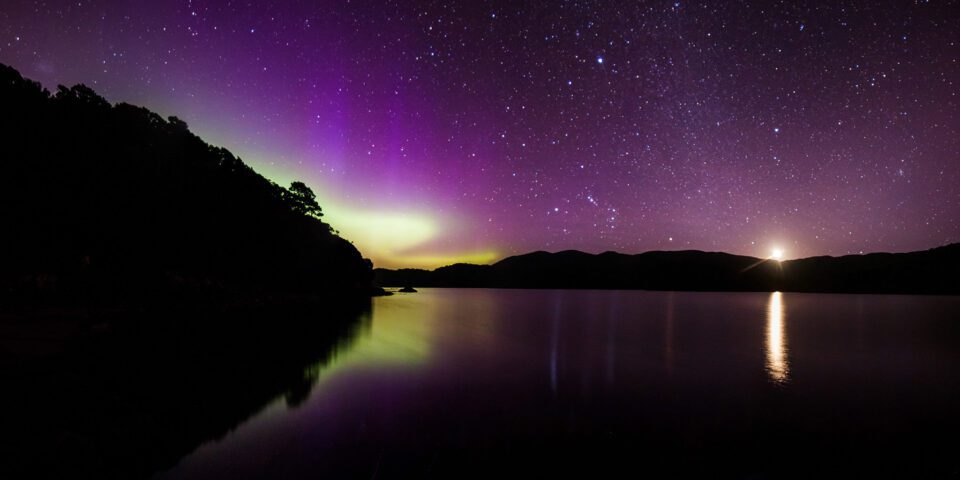
Even if I was really happy then, it would’ve been way more spectacular the previous night, simply because the viewpoint was perfect at Port William. In North Arm, the forest was far too imposing to reveal most of the Aurora… So, why would I stay there? I grabbed a map of the area and tried to find an accessible place from the track which could allow a clear view towards the south. The only way was to go north and head for the Freshwater Hut on the North West Circuit, weaving along the bay. This track is a 125 km circuit that goes around the northwest of the island, to be done in 9-11 days. This section on which I decided to walk wasn’t part of the Great Walk. That’s important detail. The DOC clearly spends less time clearing and setting up this track. Another important detail: on Rakiura it rains almost 275 days a year. Now think about the mud that can accumulate on the track at the end of autumn. It isn’t uncommon to sink up to the knees in there. But hey, I was not going to miss the Aurora just because of some mud!
I then set my headlamp to its maximum lighting capacity and sank, not in the mud but in the forest, at night, on a path that I didn’t know, looking for a place that may be inaccessible. I started to worry when the track went up and seemed to be moving away from the shore. I turned around from time to time, turned off my lamp and checked if the Aurora was still there, fearing that it would weaken before I reached my destination. Half an hour after I left the hut, the track was going down and seemed closer to the bay. I then crossed a stream and saw a gap in the forest on the left. I chose to follow the stream and after a few steps, I miraculously landed on a beach! That one seemed to be accessible only at low tide, which was right on time! The complete absence of any breeze allowed the bay to form a perfect mirror, reflecting the enthralling shapes of the Aurora:
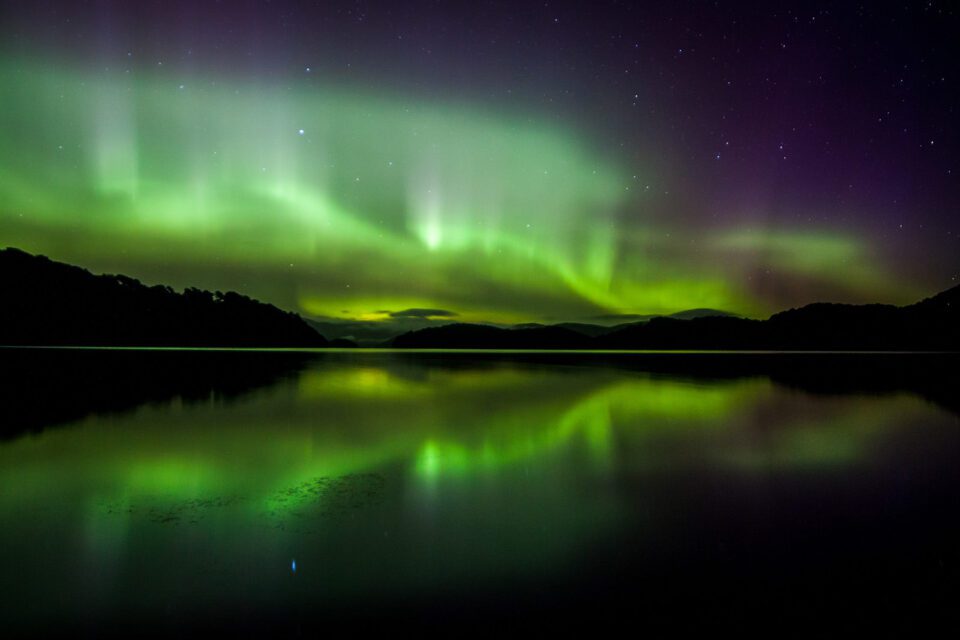
The view was ideal and, to my great surprise, the Southern light had only grown since I left. Its beams danced and created waves as hypnotizing as ephemeral. The light was so strong that my first photo was completely overexposed. I then adjusted the settings and, once again, the result displayed on the screen was staggering. The colors were unreal and yet, even if the human eye doesn’t perceive them as well as my camera, they were there, the fruit of a confrontation between our atmosphere and the solar energy.
The show was fascinating. Its rarity made this moment even more precious. After a few shots, I tried to find another point of view by moving up on the track again. New surprise of the evening: I bumped into a kiwi on the track, which froze 2 meters away from me! It then plunged back at full speed in the bush. The attempt to find another access was a failure. I hastened to finally return to my first stop and admire the end of the show. The beams rose so high in the sky that I decided to take several pictures in portrait mode in order to create two main panoramas, covering the whole extent of the Aurora:
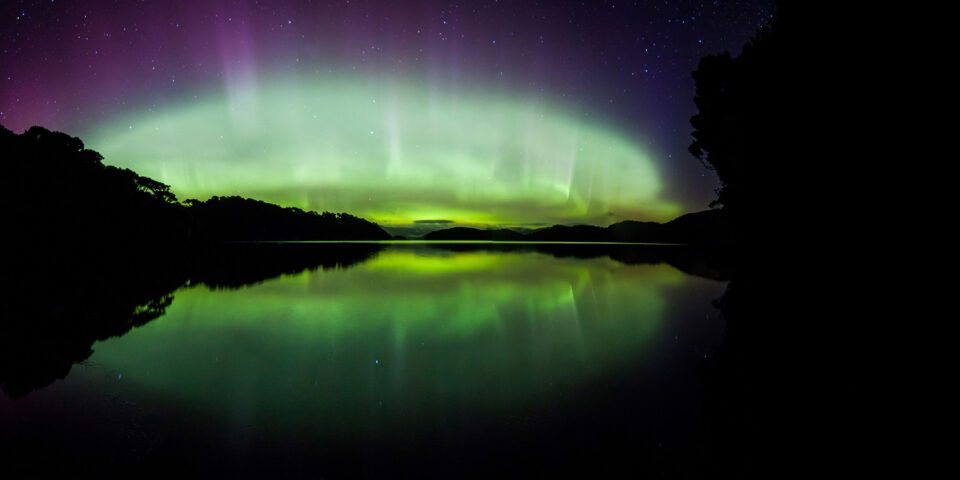
The Aurora started to fade away. Before it was too late, I took the last picture, a selfie, while illuminating the sky with my lamp. Here it is – my time has come – the aliens are abducting me:
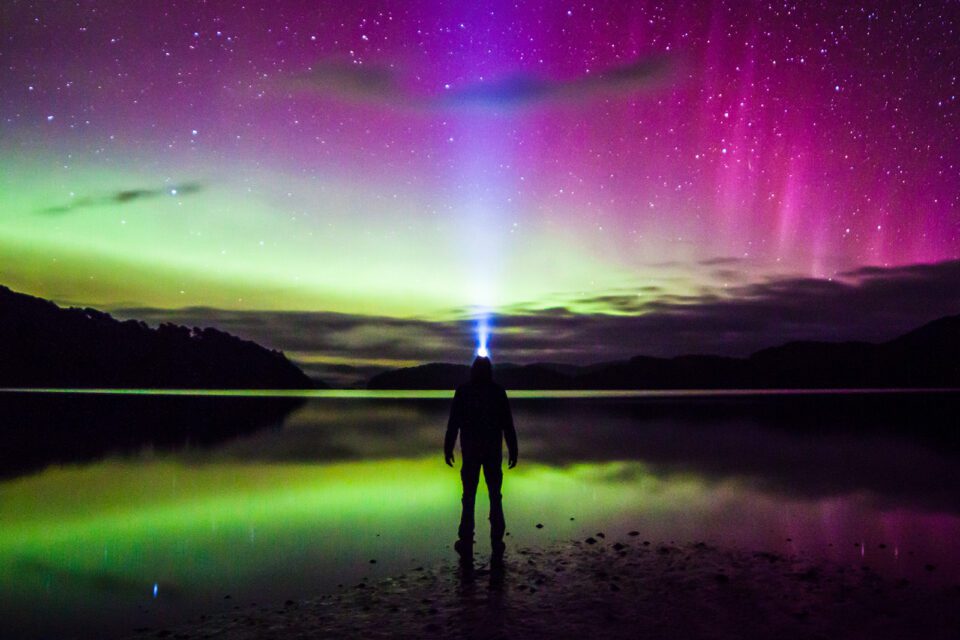
The walk back to the hut was done without a hitch and once I was there, I was asked how it was. Not bad? I grabbed a mattress from the dormitory and put it on the floor in the main room near the wood stove, just like everyone else. I fell asleep, my head full of images. What a day!
The following Monday everyone woke up in the hut at 7 AM. I still had more than an hour ahead of me before the sunrise. Enough time to drink a hot tea and eat a couple of cereal bars. I headed towards the bay, still occupied by a thick morning fog. It would soon vanish and allow the expected light to enter though. The same mirror, as during the aurora, is there:
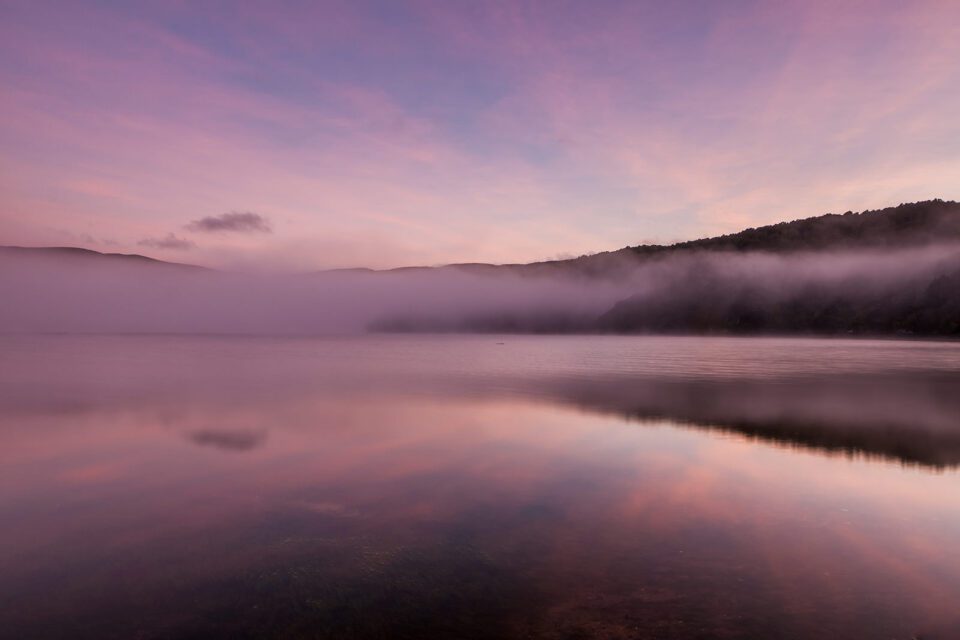
The low tide allowed me to walk along the edge of the water further than the previous night and reach a small paradisiac beach. Only the singing of birds broke the silence. Or rather the cries, those of the Oystercatchers which came in numbers to enjoy the food left by the tide. I tried to compose some pictures with those posing on the isolated rocks, seeming to float on the bay:
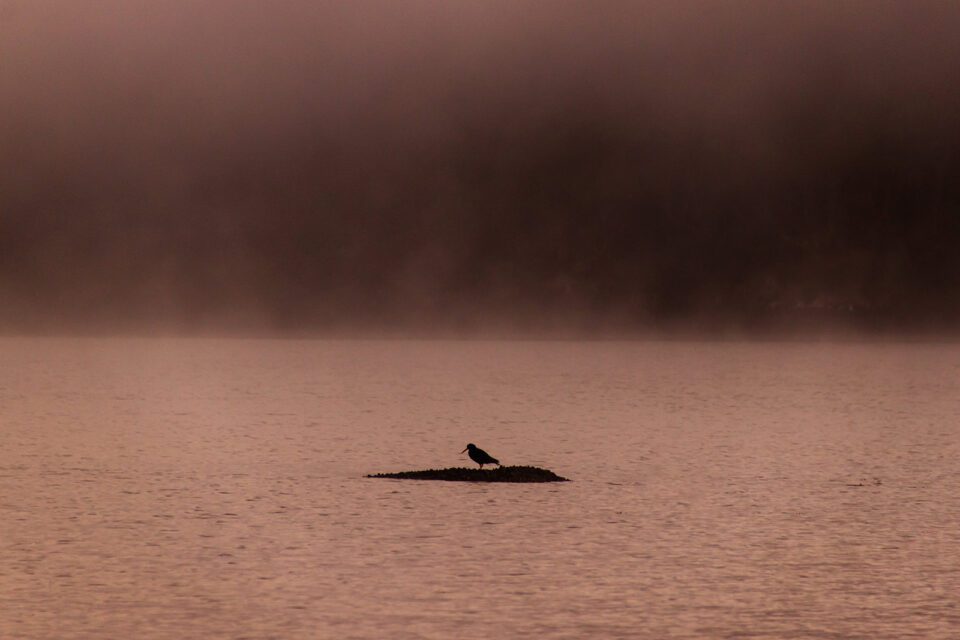
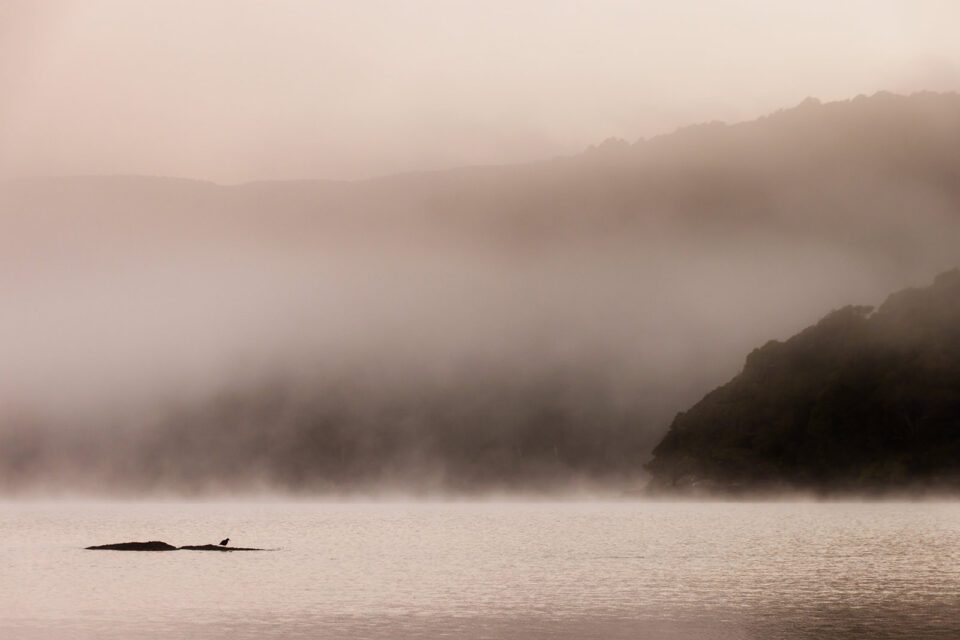
I came back to the hut, grabbed my bag and started the third and the last part of the Rakiura Track. The day then passed very quickly, walking the 12 km of this section of the track in two and a half hours. Once I arrived in Oban, I waited for the ferry with other trekkers. We left the island at 3 PM. A few albatrosses were seen from afar when we arrived the first day were now very close to the boat. Once in flight, their silhouettes weren’t hard to distinguish with any other, as their ease to fly effortlessly. Indeed, they exploit air currents formed by the waves in order to glide perfectly, a motion called dynamic soaring.
The crossing of one hour towards Bluff gave us enough time to play cards for the last time, but also to talk about what we had experienced those three days and the luck we had. The surprising kiwis, the magical Aurora Australis, the marvelous Milky Way, the fabulous wild beaches and the legendary sandflies (I already miss them). Why was I hesitating to explore this treasure?
Some people pushed me to go there – without them I would have missed this incredible adventure. Thank you, for making me live those three unforgettable days, those three days on Stewart Island, those three days at the end of the world.
All the pictures were taken with my old and faithful Canon 500D with either the Sigma 18-250mm f/3.5-6.3 or the Rokinon 14mm f/2.8.
This guest post was contributed by Maxime Sacré, nature and macro photographer based in France. To see more of his work, you can visit his webpage and if you are interested in following his photographic experiences in New Zealand, he regularly posts pictures on his Facebook page.
The post Photographing Aurora Australis on Stewart Island appeared first on Photography Life.







